Evolutionary Models of the Cenozoic Basins of Central-Western Mediterranean Area: A Review of Methodological Approaches
Abstract
1. Introduction
2. Methodological Approach
3. Geological Models
3.1. Paleogeography-Based Models
3.2. Plate Kinematics-Based Models
3.3. Tectonic and Magmatic Data-Based Models
3.4. Geophysical Study-Based Models
3.5. Paleomagnetic Study-Based Models
3.6. Underlining the Tool GPlates Software
4. Discussion and Final Remarks
Author Contributions
Funding
Acknowledgments
Conflicts of Interest
References
- Guerrera, F.; Manuel Martín-Martín, M.; Tramontana, M. Evolutionary geological models of the Central-Western Peri-Mediterranean chains: A review. Int. Geol. Rev. 2019. [Google Scholar] [CrossRef]
- Martín-Martín, M.; Guerrera, F.; Tramontana, M. Geodynamic implications of the latest Chattian-Langhian Central-Western Mediterranean volcano-sedimentary event: A review. J. Geol. 2020, 128, 29–43. [Google Scholar] [CrossRef]
- Durand Delga, M. La Méditerranée occidentale: étapes de sa genèse et problèmes structuraux liés à celle-ci. Mem. H.-Sér. Soc. Géol. 1980, 10, 203–224. [Google Scholar]
- Durand Delga, M.; Fontboté, J.M. Le cadre structural de la Méditerranée occidentale. Mém. BRGM 1980, 115, 67–85. [Google Scholar]
- Bouillin, J.P. Le “bassin maghrébin”: Une ancienne limite entre l’Europe et l’Afrique à l’ouest des Alpes. Bull. Soc. Geol. Fr. 1986, 2, 547–558. [Google Scholar] [CrossRef]
- Bouillin, J.P.; Durand Delga, M.; Olivier, P. Betic-Rifian and Tyrrhenian arcs: Distinctive features, genesis and development stages. In The Origin of Arcs; Wezel, F., Ed.; Elsevier: Amsterdam, The Netherlands, 1986; pp. 321–338. [Google Scholar]
- Vitale, S.; Zaghloul, M.N.; Tramparulo, F.D.A.; El Ouaragli, B.; Ciarcia, S. From Jurassic extension to Miocene shortening an example of polyphasic deformation in the External Dorsale Calcaire Unit (Chefchaouen, Morocco). Tectonophysics 2014, 633, 63–76. [Google Scholar] [CrossRef]
- Vitale, S.; Zaghloul, M.N.; Tramparulo, F.D.A.; El Ouaragli, B. Deformation characterization of a regional thrust zone in the northern Rif (Chefchaouen, Morocco). J. Geodyn. 2014, 77, 22–38. [Google Scholar] [CrossRef]
- Vitale, S.; Zaghloul, M.N.; El Ouaragli, B.; Tramparulo, F.D.A.; Ciarcia, S. Polyphase deformation of the Dorsale Calcaire Complex and the Maghrebian Flysch Basin Units in the Jebha area (Central Rif, Morocco): New insights into the Miocene tectonic evolution of the Central Rif belt. J. Geodyn. 2015, 90, 14–31. [Google Scholar] [CrossRef]
- Wildi, W. La chaîne tello-rifaine (Algérie, Maroc, Tunisie): Structure, stratigraphie et évolution du Trias au Miocène. Rev. Géol. Dyn. Géogr. Phys. 1983, 24, 201–297. [Google Scholar]
- Martín-Algarra, A. Evolucion Geologica Alpina del Contacto Entre las Zonas Internas y las Zonas Externas de la Cordillera Bética (Sector Centro-Occidental). Ph.D. Thesis, University of Granada, Granada, Spain, 1987. [Google Scholar]
- Guerrera, F.; Martín-Algarra, A.; Perrone, V. Late Oligocene-Miocene syn-/late-orogenic successions in western and central Mediterranean chains from the Betic cordillera to the southern Apennines. Terra Nova 1993, 5, 525–544. [Google Scholar] [CrossRef]
- Durand Delga, M.; Rossi, M.; Olivier, P.; Puglisi, D. Situation structurale et nature ophiolitique des roches basiques jurassiques associées aux flychs maghrébins du Rif (Maroc) et de Sicile (Italie). Comptes Rendus de l’Académie des Sci. -Ser. IIA-Earth Planet. Sci. 2000, 331, 29–38. [Google Scholar]
- Frizon de Lamotte, D.; Saint Bezar, B.; Bracène, R.; Mercier, E. The two main steps of the Atlas building and geodynamics of the western Mediterranean. Tectonics 2000, 19, 740–761. [Google Scholar] [CrossRef]
- Plesi, G.; Galli, M.; Daniele, G. The Mts Rognosi Ophiolithic unit (cfr. Calvana unit Auct.): Paleogeographic position in the External Ligurian domain, relationships with the tectonic units derived from Adriatic margin. Boll. Soc. Geol. Italy 2002, 1, 273–284. [Google Scholar]
- Bonardi, G.; de Capoa, P.; Di Staso, A.; Estevez, A.; Martín-Martín, M.; Martín-Rojas, I.; Perrone, V.; Tent-Manclús, J.E. Oligocene-to-Early Miocene depositional and structural evolution of the Calabria–Peloritani Arc southern terrane (Italy) and geodynamic correlations with the Spain Betics and Morocco Rif. Geodyn. Acta 2003, 16, 149–169. [Google Scholar] [CrossRef]
- de Capoa, P.; Di Staso, A.; Guerrera, F.; Perrone, V.; Tramontana, M. The extension of the Maghrebian Flysch Basin in the Apenninic Chain: Paleogeographic and paleotectonic implications. Atti Congr. “Etat des connaissances géologiques des régions nord du Maroc: La Chaîne Rifaine dans son cadre Méditérranéen occidental, Rabat (Maroc). Trav. Inst. Sci. Rabat Géografie Phys. 2003, 21, 77–92. [Google Scholar]
- de Capoa, P.; D’Errico, M.; Di Staso, A.; Perrone, V.; Perrotta, S.; Tiberi, V. The succession of the Val Marecchia Nappe (Northern Apennines, Italy) in the light pf new field and biostratigraphic data. Swiss J. Geosci. 2015, 108, 35–54. [Google Scholar] [CrossRef]
- Roca, E.; Frizon De Lamotte, D.; Mauffret, A.; Bracène, R.; Vergés, J.; Benaouali, N.; Fernandez, M.; Muñoz, J.A.; Zeyen, H. TRANSMED transect II. In The Transmed Atlas; Cavazza, W., Roure, F.M., Spakman, W., Stampfli, G.M., Ziegler, P.A., Eds.; Springer: Berlin, Germany, 2004; pp. 1–141. [Google Scholar]
- Guerrera, F.; Martín-Martín, M.; Perrone, V.; Tramontana, M. Tectono-sedimentary evolution of the southern branch of the western Tethys (Magrebian Flysch basin and Lucanian ocean). Terra Nova 2005, 17, 358–367. [Google Scholar] [CrossRef]
- Guerrera, F.; Martín-Algarra, A.; Martín-Martín, M. Tectono-sedimentary evolution of the “Numidian Formation” and Lateral Facies (southern branch of the western Tethys): Constraints for Central-Western Mediterranean geodynamics. Terra Nova 2012, 24, 34–41. [Google Scholar] [CrossRef]
- Guerrera, F.; Martín-Martín, M.; Raffaelli, G.; Tramontana, M. The Early Miocene “Bisciaro volcaniclastic event” (northern Apennines, Italy): A key study for the geodynamic evolution of the Central-Western Mediterranean. Int. J. Earth Sci. 2015, 104, 1083–1106. [Google Scholar] [CrossRef]
- Michard, A.; Negro, F.; Saddiqi, O.; Bouybaouene, M.L.; Chalouan, A.; Montigny, R.; Goffé, B. Pressure–temperature–time constraints on the Maghrebide mountain building: Evidence from the Rif–Betic transect (Morocco, Spain), Algerian correlations, and geodynamic implications. C. R. Geosci. 2006, 338, 92–114. [Google Scholar] [CrossRef]
- Perrone, V.; Martín-Algarra, A.; Critelli, S.; Decandia, F.A.; D’Errico, M.; Estevez, A.; Iannace, A.; Lazzarotto, A.; Martín-Martín, A.; Martín-Rojas, I.; et al. “Verrucano” and “Pseudoverrucano” in the Central-Western Mediterranean Alpine Chains: Paleogeographical evolution and geodynamic significance. In Tectonics of the Western Mediterranean and North Africa; Chalouan, A., Moratti, G., Eds.; Geological Society of London: London, UK, 2006; Volume 262, pp. 1–43. [Google Scholar]
- Handy, M.R.; Schmid, S.M.; Bousquet, R.; Kissling, E.; Bernoulli, D. Reconciling plate-tectonic reconstructions of Alpine Tethys with the geological–geophysical record of spreading and subduction in the Alps. Earth-Sci. Rev. 2010, 102, 121–158. [Google Scholar] [CrossRef]
- Critelli, S.; Muto, F.; Tripodi, V.; Perri, F. Relationships between lithospheric flexure, thrust tectonics and stratigraphic sequences in foreland setting: The Southern Apennines foreland basin system, Italy. Tectonics 2011, 2, 121–170. [Google Scholar]
- Critelli, S.; Muto, F.; Tripodi, V.; Perri, F. Link between thrust tectonics and sedimentation processes of stratigraphic sequences from the southern Apennines foreland basin system, Italy. Rend. Online della Soc. Geol. Ital. 2013, 25, 21–42. [Google Scholar]
- Critelli, S. Provenance of Mesozoic to Cenozoic Circum-Mediterranean sandstones in relation to tectonic setting. Earth-Sci. Rev. 2018, 185, 624–648. [Google Scholar] [CrossRef]
- Alcalá, F.J.; Guerrera, F.; Martín-Martín, M.; Raffaelli, G.; Serrano, F. Geodynamic implications derived from Numidian-like distal turbidites deposited along the Internal-External domain boundary of the Betic cordillera (S Spain). Terra Nova 2013, 26, 119–129. [Google Scholar] [CrossRef]
- Vitale, S.; Ciarcia, S. Tectono-stratigraphic and kinematic evolution of the southern Apennines/Calabria– Peloritani Terrane system (Italy). Tectonophysics 2013, 583, 164–182. [Google Scholar] [CrossRef]
- Guerrera, F.; Martín-Martín, M. Geodynamic events reconstructed in the Betic, Maghrebian, and Apennine Chains (Central-Western Tethys). Bull. Soc. Geol. Fr. 2014, 185, 329–341. [Google Scholar] [CrossRef]
- Amendola, U.; Perri, F.; Critelli, S.; Monaco, P.; Cirilli, S.; Trecci, T.; Roberto Rettori, R. Composition and provenance of the Macigno formation (Late Oligocene—Early Miocene) in the Trasimeno Lake area (Northern Apennines). Mar. Pet. Geol. 2016, 69, 146–167. [Google Scholar] [CrossRef]
- Khomsi, S.; Frizon de Lamotte, D.; Mourad Bédir, M.; Echihi, O. The late Eocene and late Miocene fronts of the Atlas Belt in eastern Maghreb: Integration in the geodynamic evolution of the Mediterranean Domain. Arab. J. Geosci. 2016, 9, 1–20. [Google Scholar] [CrossRef]
- Puga, E.; Díaz de Federico, A.; Fanning, M.; Nieto, J.M.; Rodríguez Martínez-Conde, J.A.; Díaz Puga, M.A.; Lozano, J.A.; Bianchini, G.; Natali, C.; Beccaluva, L. The Betic Ophiolites and the Mesozoic Evolution of the Western Tethys. Geosciences 2017, 7, 31. [Google Scholar] [CrossRef]
- Leprêtre, R.; Frizon de Lamotte, D.; Combie, R.V.; Gimeno-Vives, O.; Mohn, G.; Eschard, R. The Tell-Rif orogenic system (Morocco, Algeria, Tunisia) and the structural heritage of the southern Tethys margin. Bull. Soc. Geol. Fr. 2018, 189, 10. [Google Scholar] [CrossRef]
- Martín-Martín, M.; Guerrera, F.; Rodriguez-Estrella, T.; Serrano, F.; Alcalà, F.J.; Raffaelli, G.; Tramontana, M. Miocene tectono-sedimentary evolution of the eastern external Betic Cordillera (Spain). Geodin. Acta 2018, 30, 265–285. [Google Scholar] [CrossRef]
- Martín-Martín, M.; Guerrera, F.; Miclaus, C.; Tramontana, M. Similar Oligo-Miocene tectono-sedimentary evolution of the Paratethyan branches represented by the Moldavidian Basin and Maghrebian Flysch Basin. Sediment. Geol. 2020, 396, 105548. [Google Scholar] [CrossRef]
- Bullard, E.C.; Everett, J.E.; Smith, A.G. The fit of the continents around the Atlantic: A symposium on continental drift: Philosophical Transaction of the Royal Society of London. Ser. A Math. Phys. Sci. 1965, 258, 41–51. [Google Scholar]
- Smith, A.G. Alpine deformation and the oceanic areas of the Tethys, Mediterranean, and Atlantic. Geol. Soc. Am. Bull. 1971, 82, 2039–2070. [Google Scholar] [CrossRef]
- Rosenbaum, G.; Lister, G.S.; Duboz, C. Reconstruction of the tectonic evolution of the western Mediterranean since the Oligocene. J. Virtual Explor. 2002, 8, 107–130. [Google Scholar] [CrossRef]
- Rosenbaum, G.; Lister, G.S. Formation of arcuate orogenic belts in the western Mediterranean region. In Orogenic Curvature: Integrating Paleomagnetic and Structural Analyses; Sussman, A.J., Weil, A.B., Eds.; Geological Society of America: Boulder, CO, USA, 2004; Volume 383, pp. 41–56. [Google Scholar]
- Schettino, A.; Turco, E. Plate kinematics of the Western Mediterranean region during the Oligocene and Early Miocene. Geophys. J. Int. 2006, 166, 1398–1423. [Google Scholar] [CrossRef]
- Schettino, A.; Turco, E. Breakup of Pangea and plate kinematics of the central Atlantic and Atlas regions. Geophys. J. Int. 2009, 178, 1078–1097. [Google Scholar] [CrossRef]
- Schettino, A.; Turco, E. Tectonic history of the western Tethys since the Late Triassic. Geol. Soc. Am. Bull. 2011, 123, 89–105. [Google Scholar] [CrossRef]
- Chalouan, A.; Michard, A. The Alpine Rif Belt (Morocco): A case of mountain building in a subduction-subduction-transform fault triple junction. Pure Appl. Geophys. 2004, 161, 489–519. [Google Scholar] [CrossRef]
- Boyden, J.A.; Müller, R.D.; Gurnis, M.; Torsvik, T.H.; Clark, J.A.; Turner, M.; Ivey-Law, H.; Watson, R.J.; Cannon, J.S. Next-generation plate-tectonic reconstructions using GPlates. In Geoinformatics: Cyberinfrastructure for the Solid Earth Sciences; Randy Keller, G., Baru, C., Eds.; Cambridge University Press: Cambridge, UK, 2011; pp. 95–113. [Google Scholar]
- van Hinsbergen, D.J.J.; Vissers, R.L.M.; Spakman, W. Origin and consequences of western Mediterranean sub- duction, rollback, and slab segmentation. Tectonics 2014, 33, 393–419. [Google Scholar] [CrossRef]
- Brune, S.; Williams, S.E.; Butterworth, N.P.; Müller, R.D. Abrupt plate accelerations shape rifted continental margins. Nature 2016, 536, 201–204. [Google Scholar] [CrossRef] [PubMed]
- Scotese, C.R.; Schettino, A. Late Permian-Early Jurassic paleogeography of Western Tethys and the World. In Permo-Triassic Salt Provinces of Europe, North Africa and the Atlantic Margins; Soto, J.I., Flinch, J., Tari, G., Eds.; Elsevier: Amsterdam, The Netherlands, 2017; p. 632. [Google Scholar]
- Müller, R.D.; Zhirovic, S.; Williams, S.E.; Cannon, J.; Seton, M.; Bower, D.J.; Tetley, M.G.; Heine, C.; Le Breton, E.; Liu, S.; et al. A Global Plate Model including lithospheric deformation along major rifts and orogens since the Triassic. Tectonics 2018, 38, 1884–1907. [Google Scholar] [CrossRef]
- Brune, S. Earth’s Major Post-Pangea Rift Systems. 2018. Available online: http://portal.gplates.org/cesium/?view=rift_v (accessed on 12 September 2020).
- Paleogeography (750 Ma—Present-Day). Available online: https://www.youtube.com/watch?v=tObhGzHH2aw&ab_channel=ChristopherScotese (accessed on 12 September 2020).
- van Hinsbergen, D.J.J. Mediterranean Paleogeographic Reconstructions. 2018. Available online: http://www.geologist.nl/reconstructions/ (accessed on 12 September 2020).
- Carminati, E.; Doglioni, C. Alps vs. Apennines: The paradigm of a tectonically asymmetric Earth. Earth-Sci. Rev. 2012, 112, 67–96. [Google Scholar] [CrossRef]
- Carminati, E.; Lustrino, M.; Doglioni, C. Geodynamic evolution of the central and western Mediterranean: Tectonics vs igneous petrology constraints. Tectonophysics 2012, 579, 173–192. [Google Scholar] [CrossRef]
- Savelli, C. Fast episodes of West-Mediterranean-Tyrrhenian oceanic opening and revisited relations with tectonic setting. Sci. Rep. 2015, 5, 1–11. [Google Scholar] [CrossRef]
- Mattioli, M.; Lustrino, M.; Ronca, S.; Bianchini, G. Alpine subduction imprint in Apennine volcaniclastic rocks. Geochemical-petrographic constraints and geodynamic implications from Early Oligocene Aveto-Petrignacola Formation (N Italy). Lithos 2012, 134, 201–220. [Google Scholar] [CrossRef]
- Doglioni, C. Main differences between thrust belts. Terra Nova 1992, 4, 152–164. [Google Scholar] [CrossRef]
- Lonergan, L.; White, N. Origin of the Betic-Rif mountain belt. Tectonic 1997, 16, 504–522. [Google Scholar] [CrossRef]
- Brun, J.P.; Faccenna, C. Exhumation of high-pressure rocks driven by slab rollback. Earth Planet. Sci. Lett. 2008, 272, 1–7. [Google Scholar] [CrossRef]
- Vergés, J.; Fernández, M. Tethys-Atlantic interaction along the Iberia-Africa plate boundary: The Betic-Rif orogenic system. Tectonophysics 2012, 579, 144–172. [Google Scholar] [CrossRef]
- Bezada, M.J.; Humphreys, E.D.; Toomey, D.R.; Harnafi, M.; Dávila, J.M.; Gallart, J. Evidence for slab rollback in westernmost Mediterranean from improved upper mantle imaging. Earth Planet. Sci. Lett. 2013, 368, 51–60. [Google Scholar]
- Calvert, A.; Sandovol, E.; Seber, D.; Barazangi, M.; Roecker, S.; Mourabit, T.; Vidal, F.; Alguacil, G.; Jabour, N. Geodynamic evolution of the lithosphere and upper mantle beneath the Alboran region of the western Mediterranean: Constraints from travel time tomography. J. Geophys. Res. 2000, 105, 10871–10898. [Google Scholar] [CrossRef]
- de Lis Mancilla, F.; Stich, D.; Berrocoso, M.; Martín, R.; Morales, J.; Fernandez-Ros, A.; Páez, R.; Pérez-Peña, A. Delamination in the Betic Range: Deep structure, seismicity, and GPS motion. Geology 2013, 41, 307–310. [Google Scholar] [CrossRef]
- Vissers, R.L.M. Extension in a convergent tectonic setting: A lithospheric view on the Alboran system of SW Europe. Geol. Belg. 2012, 15, 53–72. [Google Scholar]
- Williams, J.R.; Platt, J.P. A new structural and kinematic framework for the Alborán domain (Betic–Rif arc, western Mediterranean orogenic system). J. Geol. Soc. 2018, 175, 465–496. [Google Scholar] [CrossRef]
- Platt, J.P.; Vissers, R.L.M. Extensional collapse of thickened continental lithosphere: A working hypothesis for the Alboran Sea and Gibraltar arc. Geology 1989, 17, 540–543. [Google Scholar] [CrossRef]
- Viti, M.; Mantovani, E.; Babbucci, D.; Tamburelli, C. Generation of trench-arc-back arc systems in the Western Mediterranean Region driven by plate convergence. Ital. J. Geosci. 2009, 128, 89–106. [Google Scholar]
- Belayouni, H.; Brunelli, D.; Clocchiati, R.; Di Staso, A.; El Amrani El Hassani, I.; Guerrera, F.; Kassaa, S.; Laridhiouazaa, N.; Martín-Martín, M.; Serrano, F.; et al. La Galite Archipelago (Tunisia, North Africa): Stratigraphic and petrographic revision and insights for geodynamic evolution of the Maghrebian Chain. J. Afr. Earth Sci. 2010, 56, 15–28. [Google Scholar] [CrossRef]
- Zeck, H.P. Betic-Rif orogeny: Subduction of Mesozoic Tethys lithosphere under eastward drifting Iberia, slab detachment shortly before 22 Ma, and subsequent uplift and extensional tectonics. Tectonophysics 1996, 254, 1–16. [Google Scholar] [CrossRef]
- Lowrie, W.; Heller, F. Magnetic properties of marine limestones. Rev. Geophys. Space Phys. 1982, 20, 171–192. [Google Scholar] [CrossRef]
- Lowrie, L.; Alvarez, W. Paleomagnetic evidence for rotation of the Italian Peninsula. J. Geophys. Res. 1994, 80, 1579–1592. [Google Scholar] [CrossRef]
- Scheepersa, P.J.J.; Langereisa, C.G.; Zijdervelda, J.D.A.; Hilgenb, F.J. Paleomagnetic evidence for a Pleistocene clockwise rotation of the Calabro-Peloritan block (southern Italy). Tectonophysics 1994, 230, 19–48. [Google Scholar] [CrossRef]
- Durand, B.; Jolivet, L.; Horvath, F.; Séranne, M. The Mediterranean Basins: Tertiary Extension within the Alpine Orogen; Geological Society of London: London, UK, 1999; p. 570. [Google Scholar]
- Jolivet, L.; Faccenna, C. Mediterranean extension and the Africa-Eurasia collision. Tectonic 2000, 19, 1095–1106. [Google Scholar] [CrossRef]
- Vitale, S.; Amore, O.F.; Ciarcia, S.; Fedele, L.; Grifa, C.; Prinzi, E.P.; Tavani, S.; Tramparulo, F.D.A. Structural, stratigraphic and petrological clues for a Cretaceous-Paleogene abortive rift in the southern Adria domain (Southern Apennines, Italy). Geol. J. 2018, 53, 660–681. [Google Scholar] [CrossRef]
- Amadori, M.L.; Belayouni, H.; Guerrera, F.; Martín-Martín, M.; Martin-Rojas, I.; Miclăuş, C.; Raffaelli, G. New data on the Vrancea Nappe (Moldavidian Basin, Outer Carpathian Domain, Romania): Paleogeographic and geodynamic reconstructions. Int. J. Earth Sci. 2012, 101, 1599–1623. [Google Scholar] [CrossRef]
- Guerrera, F.; Martín-Martín, M.; Martin-Rojas, I.; Miclăuş, C.; Serrano, F.; Martín-Pérez, J.A. Tectonic control on the sedimentary record of the central Moldavidian Basin (Eastern Carpathians, Romania). Geol. Carpathica 2012, 63, 463–479. [Google Scholar]
- Benzeggagh, M.; Abdelkhader Mokhtari, A.; Philippe Rossi, P.; Michard, A.; Abdelkhader El Maz, A.; Chalouan, A.; Saddiqi, O.; Rjimati, E.C. Oceanic units in the core of the External Rif (Morocco): Intramargin hiatus or South-Tethyan remnants? J. Geodyn. 2014, 77, 4–21. [Google Scholar] [CrossRef]
- Fernandez, L.; Bosch, D.; Bruguier, O.; Hammor, D.; Caby, R.; Arnaud, N.; Monié, P.; Abdallah, N.; Verdoux, P.; Ouabadi, A.; et al. Vestiges of a fore-arc oceanic crust in the Western Mediterranean: Geochemical constraints from North-East Algeria. Lithos 2020, 370, 105649. [Google Scholar] [CrossRef]
- Gimeno-Vives, O.; Frizon de Lamotte, D.; Leprêtre, R.; Haissen, F.; Atouabat, A.; Mohn, G. The structure of the Central-Eastern External Rif (Morocco); Poly-phased deformation and role of the under-thrusting of the North-West African paleo-margin. Earth-Sci. Rev. 2020, 205, 103198. [Google Scholar] [CrossRef]
- Michard, A.; Mokhtari, A.; Chalouan, A.; Saddiqi, O.; Rossi, P.; Rjimati, E.C. New ophiolite slivers in the External Rif belt, and tentative restoration of a dual Tethyan suture in the western Maghrebides. Bull. Soc. Geol. Fr. 2014, 185, 313–328. [Google Scholar] [CrossRef]
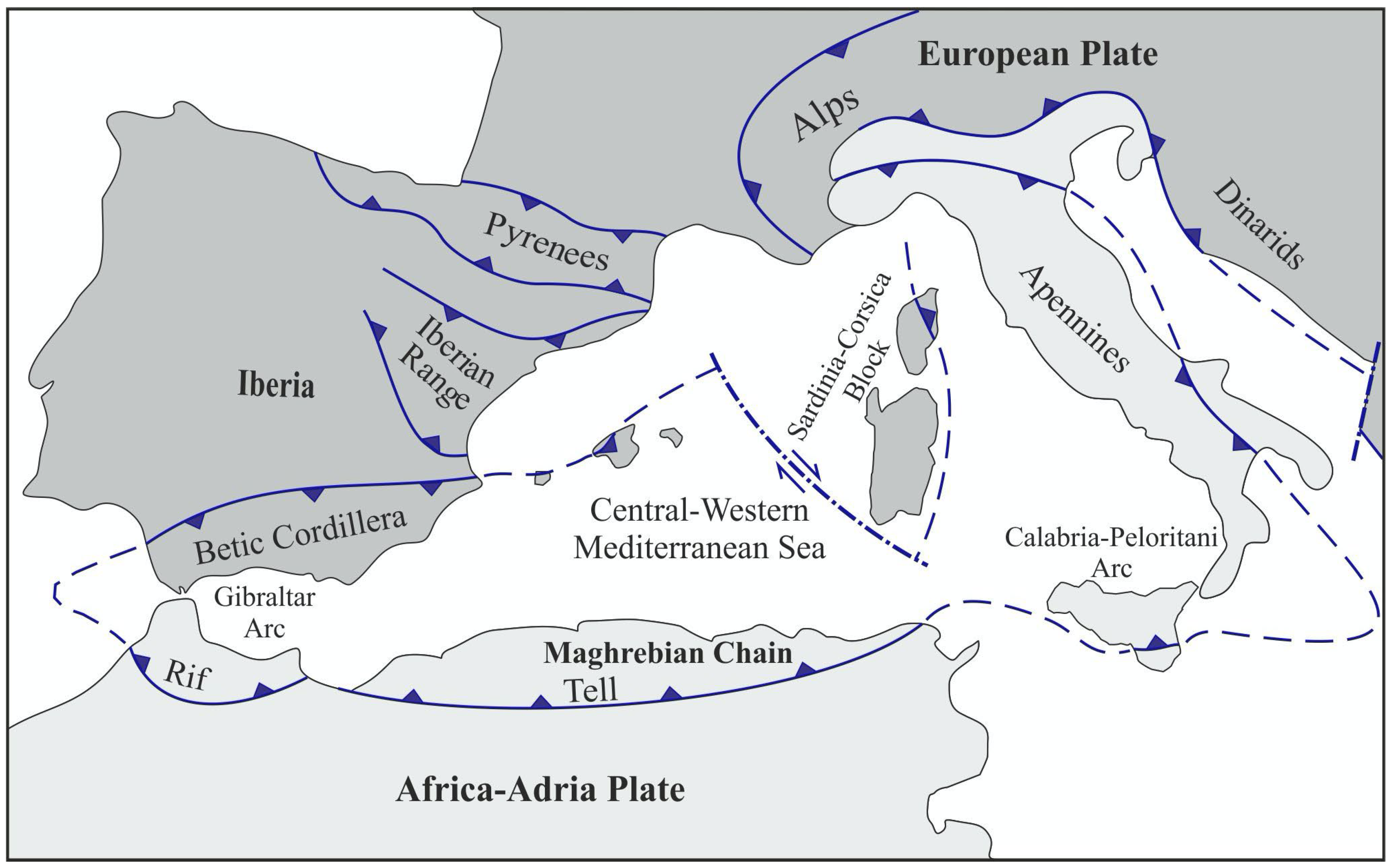
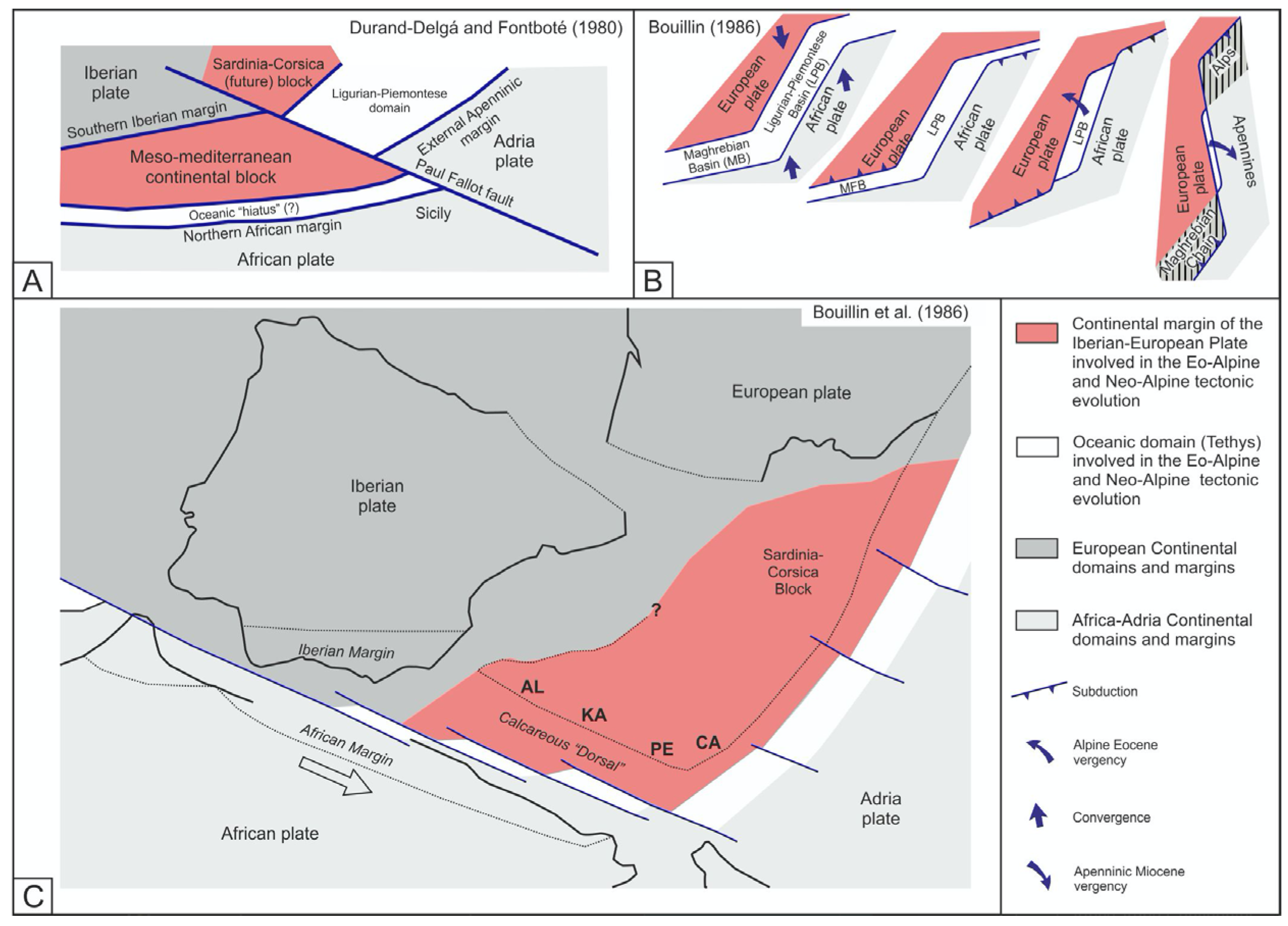
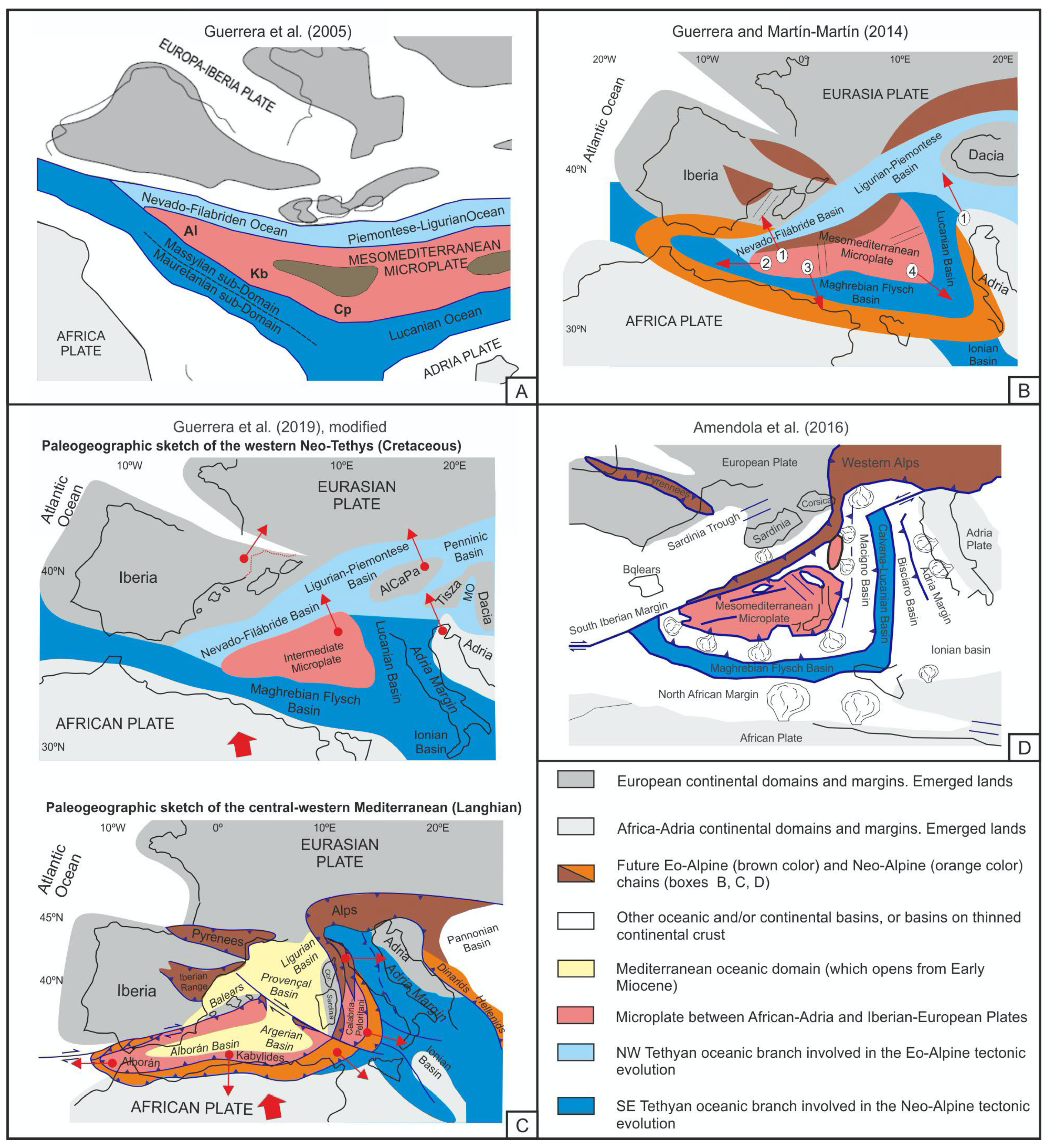
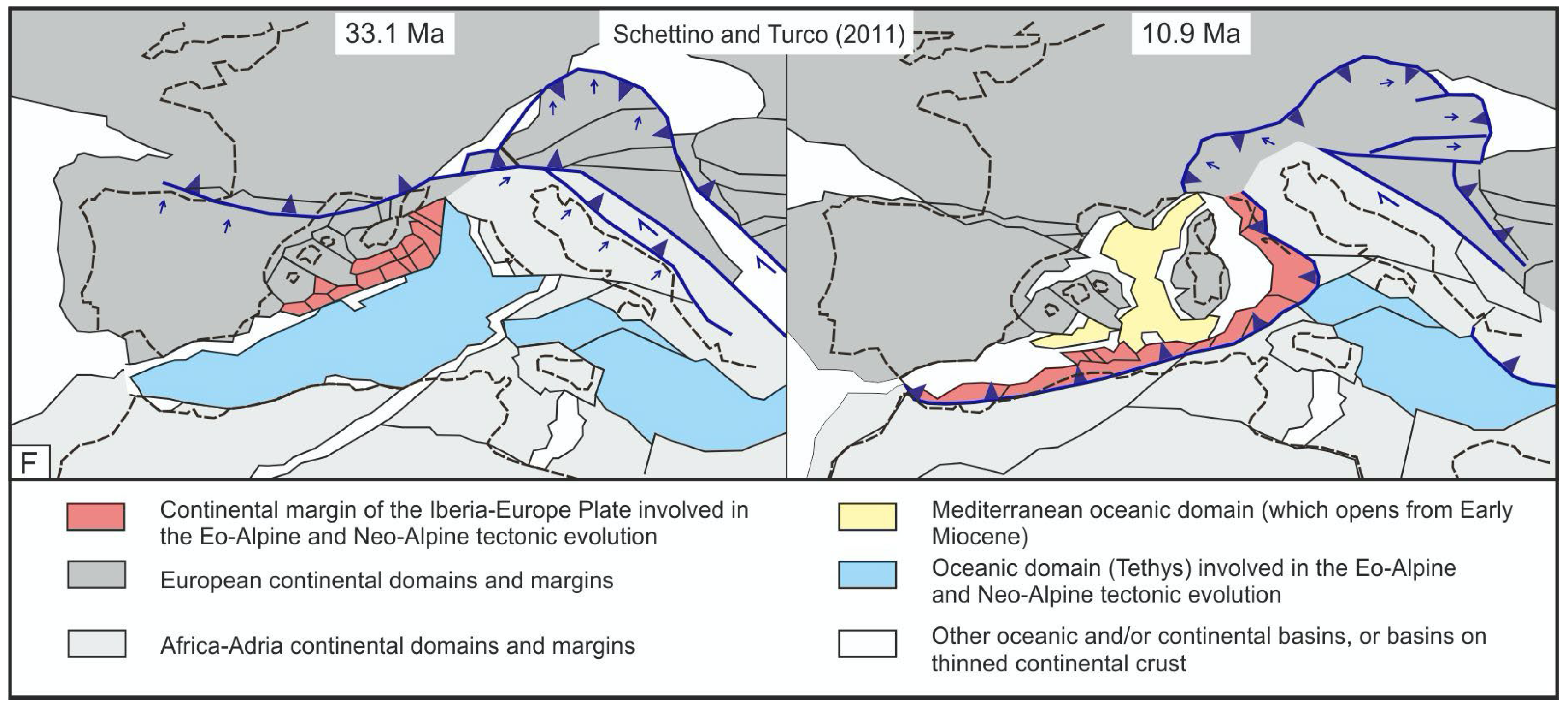

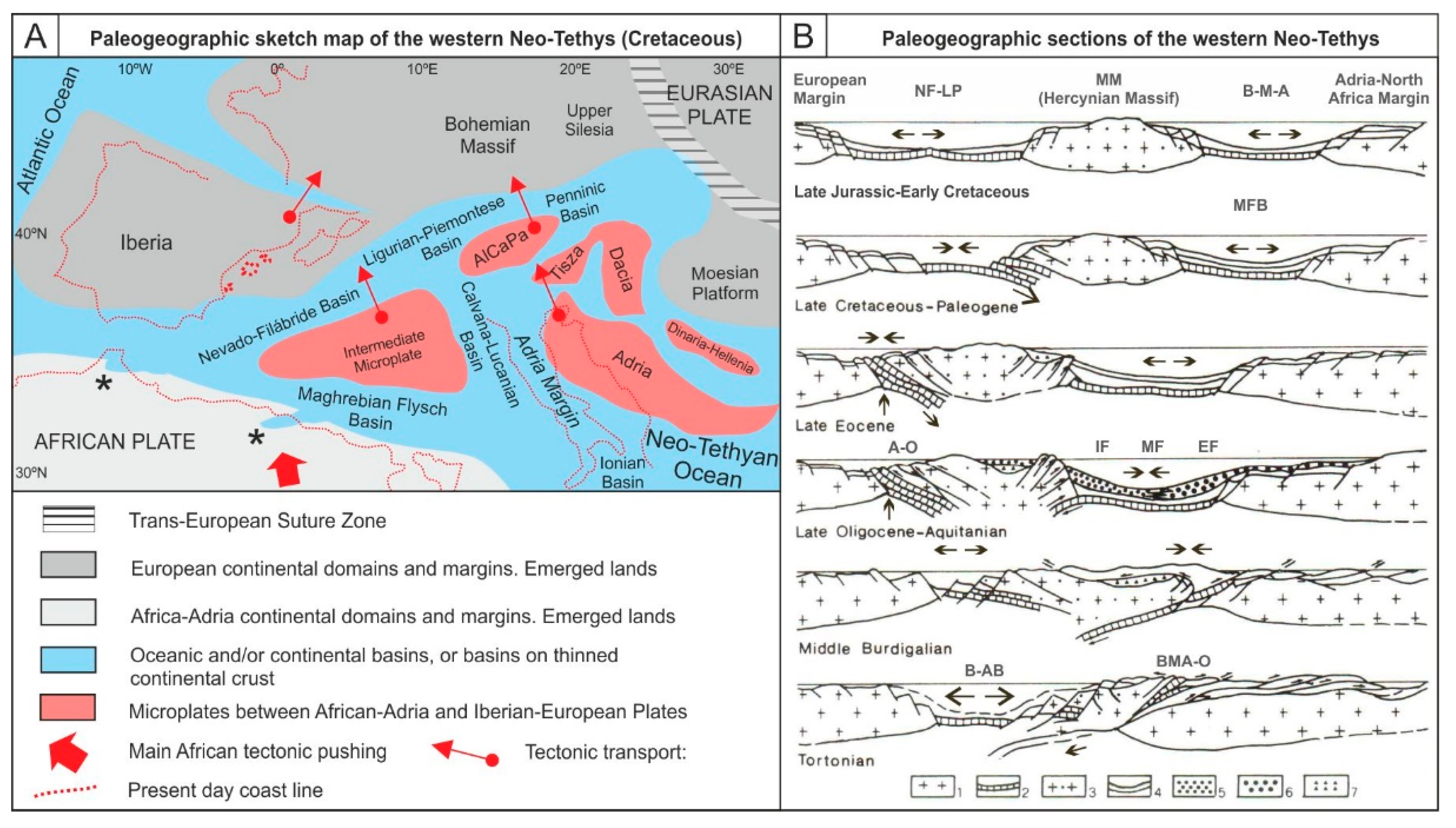
| Time Range | Sectors with Eo-Alpine Tectono-Sedimentary Evolution * | Sectors with Neo-Alpine Tectono-Sedimentary Evolution | Main Basin Evolutionary Stages | Main Geodynamic Events | ||||
|---|---|---|---|---|---|---|---|---|
| Betic Cordillera-Rif-Tell | Sicilian Maghrebids | Apennines | ||||||
| Late Miocene-Pliocene |  |  |  |  | Molassic and/or intramontane basin (new sedimentary cycle) | Extension and strike-slip deformation (post orogenic phase) | ||
| Middle Miocene | Serrav. |  Occurrence of Post-Alpine deformation |  |  |  | Thrust-top basin  or piggy-back basin  and gravity sliding | Late-orogenic phase (continental collision) | |
 | ||||||||
| Lang. |  | |||||||
| Early Miocene | Burdig. |  | Foredeep stage (huge amount of siliciclastic supply with subordinate volcaniclastites) | Subduction (syn-orogenic phase) | ||||
| Aquit. |  |  | ||||||
| Paleogene | Oligoc. | |||||||
 ?  |  | Start of terrigenous supply (pre-foredeep stage) | Start of tectonic inversion (compressional phase with gentle folding and blind-thrusts) Abortive rifting | |||||
| Eoc. | ||||||||
| Paleoc. | ||||||||
| Cretaceous | Late |  |  | |||||
 |  |  |  | Marine pelagic depositional stage | Drifting phase | |||
| Early | ||||||||
 ?  |  |  |  | Oceanization phase | ||||
| Jurassic | Malm | |||||||
| Dogger | ||||||||
 |  |  |  | Rifting phase | ||||
| Liassic |  |  | ||||||
| Triassic | Late | |||||||
| Early |  |  | Continental depositional stage | Pre-rifting (start of extensional phase) | ||||
© 2020 by the authors. Licensee MDPI, Basel, Switzerland. This article is an open access article distributed under the terms and conditions of the Creative Commons Attribution (CC BY) license (http://creativecommons.org/licenses/by/4.0/).
Share and Cite
Guerrera, F.; Martín-Martín, M.; Tramontana, M. Evolutionary Models of the Cenozoic Basins of Central-Western Mediterranean Area: A Review of Methodological Approaches. Geosciences 2020, 10, 366. https://doi.org/10.3390/geosciences10090366
Guerrera F, Martín-Martín M, Tramontana M. Evolutionary Models of the Cenozoic Basins of Central-Western Mediterranean Area: A Review of Methodological Approaches. Geosciences. 2020; 10(9):366. https://doi.org/10.3390/geosciences10090366
Chicago/Turabian StyleGuerrera, Francesco, Manuel Martín-Martín, and Mario Tramontana. 2020. "Evolutionary Models of the Cenozoic Basins of Central-Western Mediterranean Area: A Review of Methodological Approaches" Geosciences 10, no. 9: 366. https://doi.org/10.3390/geosciences10090366
APA StyleGuerrera, F., Martín-Martín, M., & Tramontana, M. (2020). Evolutionary Models of the Cenozoic Basins of Central-Western Mediterranean Area: A Review of Methodological Approaches. Geosciences, 10(9), 366. https://doi.org/10.3390/geosciences10090366






